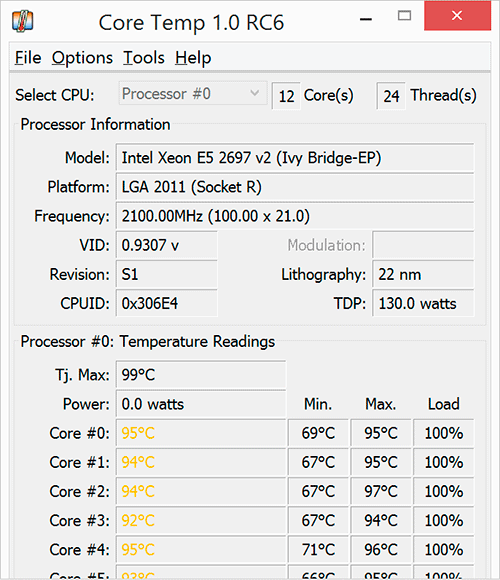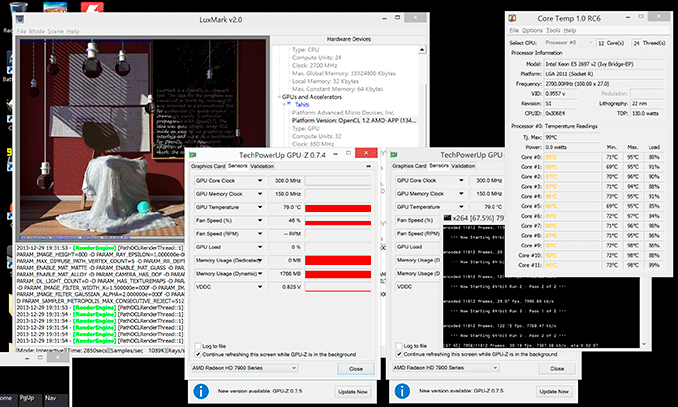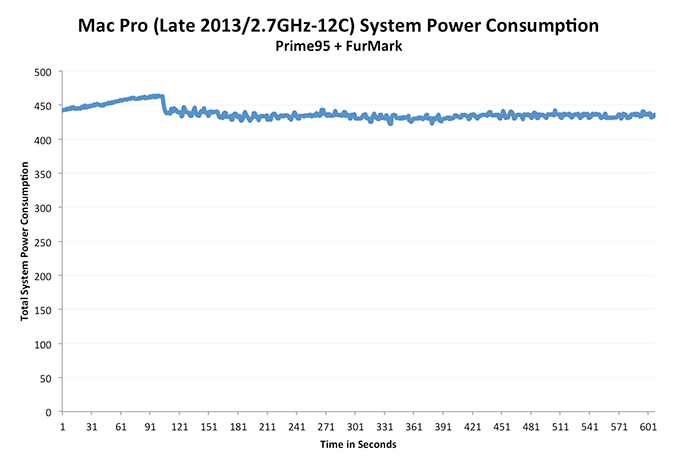The Mac Pro Review (Late 2013)
by Anand Lal Shimpi on December 31, 2013 3:18 PM ESTPower Consumption & Noise
The Mac Pro’s thermal core makes a lot of sense from an area efficiency standpoint as the chances that you have all three processors in the system (Xeon CPU + dual AMD FirePro GPUs) running at max speed at the same time is highly unlikely. By having all three players share one large heatsink Apple can optimize for the most likely usage scenarios where at most one processor is running at close to max TDP. From the moment the system was introduced however I was curious to see if its thermal design could deal with all three processors going full tilt. I decided to test both scenarios out.
The vast majority of the time the Mac Pro’s single fan spins at a paltry 769 RPM. At this speed the Mac Pro is virtually silent. I have a Promise Pegasus R6 Thunderbolt chassis with four 3.5” 7200 RPM hard drives inside. The Pegasus sits four feet away from my Mac Pro and at idle the hum of its drives drowns out the idle fan noise of the Mac.
Even running heavily threaded CPU benchmarks does nothing to impact fan speed. It's not until you run a prolonged workload that you can hear an increase in noise from the Mac Pro. I ran FurMark under OS X in parallel with a relatively heavy 4K render in Final Cut Pro. I was rendering a 20 minute 4K project with two effects applied across the entire timeline. The basic render used up 4 - 8 threads, while the effects ensured the compute GPU had some work to do. FurMark obviously kept the display GPU busy. After around 25% of the rendering task was complete the Mac Pro’s fan smoothly scaled up to 1400 RPM, then 1600 RPM and finally stopping at what I believe is full speed: 1900 RPM.
I crudely measured noise sitting at my desk, approximately 18” away from the Mac Pro at all of these points:
| Mac Pro (Late 2013) Fan Noise vs. RPM | ||||||
| Fan Speed (RPM) | Measured Sound Pressure Level @ 18" | |||||
| Off | 32.2 dBA | |||||
| 770 RPM | 32.4 dBA | |||||
| 890 RPM | 32.8 dBA | |||||
| 1097 RPM | 34.1 dBA | |||||
| 1193 RPM | 35.2 dBA | |||||
| 1440 RPM | 38.6 dBA | |||||
| 1500 RPM | 39.4 dBA | |||||
| 1900 RPM | 44.7 dBA | |||||
System noise isn’t an issue the vast majority of the time. Even if you’re running for short bursts with everything cranking away on a problem. It’s only under prolonged use of the CPU + both GPUs that the fan has to spin up this high. I quit FurMark and kept the FCP render going, which brought system power down from ~380W to ~326W. It also slowly dropped fan speed from 1900 RPM down to 1500 RPM before smoothly alternating between 1200 RPM and 1450 RPM. The way the Mac Pro’s fan ramps is actually just as important as its ability to remove heat. There are no dramatic increases in speed, just an incredibly smooth curve that the Pro’s fan moves up and down.
The system never gets annoyingly loud, it just varies between silent and calmly reminding you that there’s a large fan inside. Even at full bore the Mac Pro’s fan noise is more pleasant than harsh. It’s not magic, just good system design coupled with the fact that even with a pair of D700s Apple went a bit conservative on GPU speed. Had this been a system capable of pulling 800W at the wall, we’d be having a different discussion about noise.
My next task was to see what actually happens in this worst case scenario. If you’re running all of the parts at full tilt, are any of them going to throttle? I have to work pretty hard to get the fan to spin up under OS X, but in Windows it’s a lot easier since I can just toss a single multi-GPU workload at the problem.
I started out by running LuxMark, an OpenCL workload, on both GPUs as well as a multithreaded 7-Zip benchmark on all of the CPU cores. I monitored both CPU and GPU frequencies. The result was no throttling across the board:
Getting an accurate reading on GPU frequencies from Tahiti based GPUs ends up being harder than I expected, but I saw what Ryan reminded me is typical behavior where the GPUs alternate between their 650MHz base clock and 850MHz max turbo. We don’t have good tools to actually measure their behavior in between unfortunately.
The same was true for the CPU. Even with all 12 cores taxed heavily, I never saw any drops below the CPU’s 2.7GHz base clock.
Next I tried a heavier workload on the CPU: a H.264 video encode. Here I just ran the x264 5.01 benchmark in parallel with the LuxMark workload. Once again, I saw no drop in CPU or GPU clocks although I believe I was approaching the limits of where that would hold true. The system was pulling an average of 410W at that point, with peak power draw at 429W.
If you’re wondering, there was little to no impact on the x264 benchmark from having LuxMark run in the background. The first rendering pass took about a 3% hit, likely due to the CPU not being able to turbo as high/at all, but the second heavily threaded pass was on par with my standalone run without LuxMark in the background. LuxMark on the other hand saw around a 14% reduction in performance, from 2040K samples per second down to 1750K when run in parallel with the x264 test. We’re still talking about two extremely compute intensive tasks, the fact that I can run both with little performance reduction is an example of the sort of performance scaling that’s possible if you leverage all of the compute in the Mac Pro.
So far I wasn’t surprised by the platform’s behavior. The Mac Pro’s thermal core and fan was enough to handle a real world workload without throttling. But what about a power virus? For this I ran a combination of FurMark at 2560 x 1440 and Prime95 (in-place large FFTs) across all GPUs and CPU cores.

The GPUs peaked at 97C, which is pretty much as high as a 28nm Tahiti should ever go. The CPU hit a similar temperature, with most cores hovering around 95C. GPU clocks seemed ok, with both GPUs running between 650 - 850MHz (base - boost). The CPU on the other hand dropped down to 2.1GHz (I even saw a short excursion down to 2GHz). Average power while running this workload was 437W, peaking at 463W before CPU throttling kicked in. If you plot out a graph of power vs. time you can see the CPU throttling kick in during the workload.
I have to stress that I haven’t been able to get this to happen in any normal workload, only what’s effectively a power virus for the GPUs and something quite unrealistic for the CPUs. Either way it shows us the upper limit of what the thermal core can do.
Overall power consumption is down considerably compared to previous generation Mac Pros:
| Mac Pro Power Consumption | ||||||
| Idle | Multithreaded CPU Load | |||||
| Apple Mac Pro (Late 2013/2.7GHz-12C) | 85.5W | 190.7W (Cinebench 11.5) | ||||
| Apple Mac Pro (Early 2009/2.93GHz-8C) | 125.3W | 254W (Cinebench R10) | ||||
| Apple PowerMac G5 Dual 2.5GHz | 120.8W | 252.2W (Cinebench R10) | ||||
Idle power consumption is down and power efficiency under load is way better than the early 2009 Mac Pro I have here. As far as I can tell, max power consumption for either compute system (CPU alone or dual GPUs alone) is around 300 - 320W. With both subsystems combined you'll get the 437W figure I talked about earlier.
You don't even need a power virus to get there. Running two realistic workloads that are heavy enough won't get you up to the 463W point where I saw throttling, but it'll get you close to the max average power I recorded on the Mac Pro.















267 Comments
View All Comments
JlHADJOE - Wednesday, January 1, 2014 - link
AFAIK the D700 is also a FirePro, and also has ECC on its VRAM.tipoo - Wednesday, January 1, 2014 - link
Wrong, it has no ECC. On OSX Apple writes much of the graphics driver anyways, so they can get away with calling Radeons FirePros as ECC isn't a necessity to call them that.Kevin G - Wednesday, January 1, 2014 - link
ECC on the FirePro's doesn't actually add additional RAM like it does on traditional server DIMM's. Instead as RAID5 like parity is performed on GPU memory channels to be able to be able to detect a memory error. Thus the 6 GB card will only have 5.25 GB available to use with ECC enabled. Since all the memory channel have to be used for a memory access, performance in some workloads takes a significant hit. I believe by default ECC is disabled for performance and memory capacity reasons.There is also one other difference between the D700 and the W9000: clock speeds and voltages. The D700 runs are a lower clock speed by default and presumably lower voltage to cut power consumption.
DaveGirard - Wednesday, January 1, 2014 - link
the D700 is clocked lower than the W9000. It's at 850MHz instead of 950.lilo777 - Wednesday, January 1, 2014 - link
Except it does not have ECC memory or the Pro drivers which are the only things that differentiate Pro from consumer grade cards. As such they are consumers grade cards (and the two year old generation) which cost around $700 at most not the $3500 pro cards.japtor - Wednesday, January 1, 2014 - link
There's never been a pro driver distinction in OS X, Radeons are validated for pro apps in OS X like FirePros in Windows. Granted there hasn't been the pro branding until now, but Apple does the drivers iirc so I don't see them bothering with splitting the driver base like AMD does.melgross - Wednesday, January 1, 2014 - link
You know nothing about Apple's drivers. I would bet that at the very least, they are based on the pro driver configurations, as apple has little interest in gaming, and a lot of interest in pro users. If you look at the performance of this in a pro app you can see that performance is pretty good. Mac Pro's are used in NASA, drug company research labs, CAD shops, video, photography labs and studios and publishing. Game drivers are of no interest to them.solipsism - Tuesday, December 31, 2013 - link
Note that he speculates that the CPU would be soldered (something no Mac Pro has ever had) and the thermal cap removed (something I believe Apple had only done once).Also note he doesn't have any more PCIe available for the SSD so he ends up going with the much slower SATA version but to make up some of the speed he gets 2x512GB in a RAID 0 configuration.
I like the case they used and I'm expect to see *more* of these smaller cases hit the market for DIYer and from OEMs now that Apple has stepped in.
Lonyo - Wednesday, January 1, 2014 - link
There are lots of small cases on the market and there have been for a while now... sure there could be more, but they are already widely available with a hell of a lot of variety of designs... not sure exactly how you think Apple will have any real impact on this market.If anything is going to have an impact it would be Steam boxes because OEMs might start pulling their fingers out and designing more gaming oriented small boxes, although they also are already rather common, but not always available for end users, such as the Alienware system which has a horizontal GPU mount with a riser.
solipsism - Wednesday, January 1, 2014 - link
Where are all these OEM PCs with very small cases but high performance like the new Mac Pro?